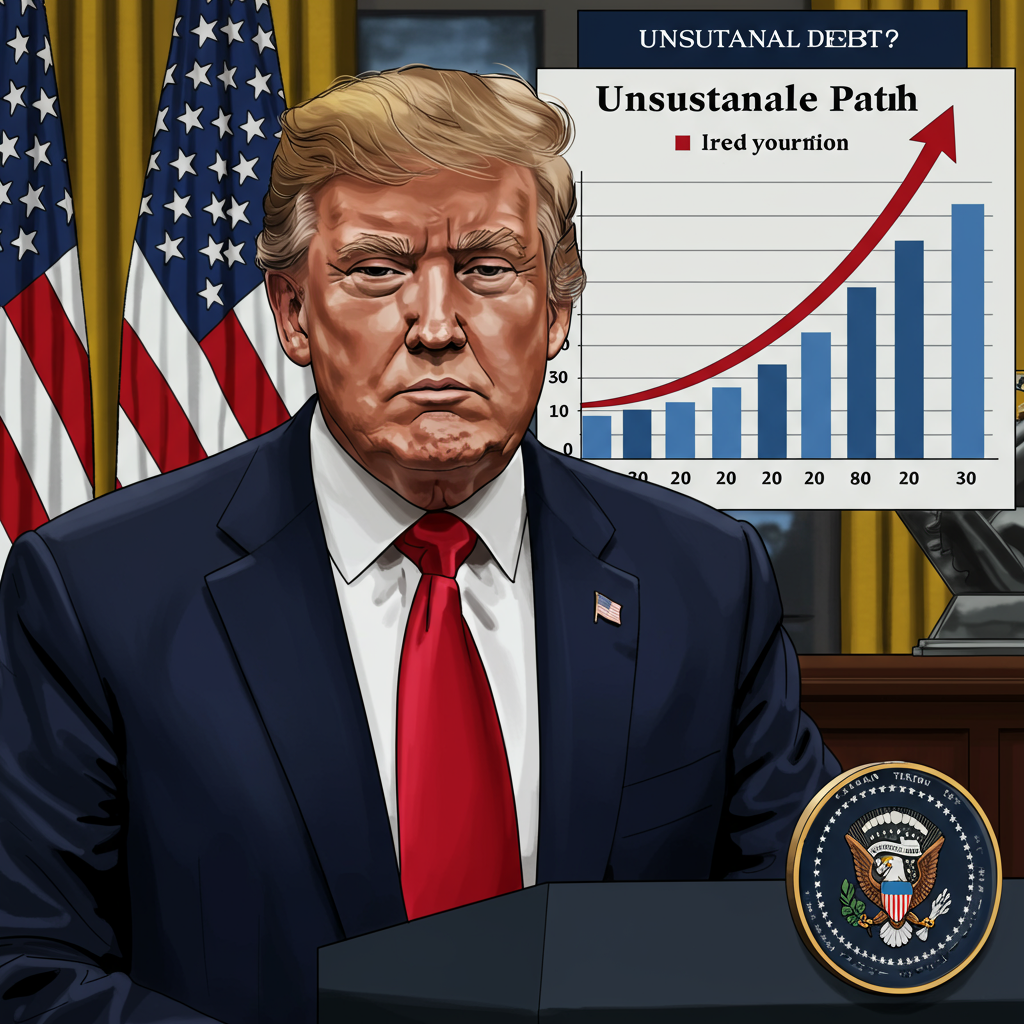The U.S. national debt is on a trajectory toward “unsustainable” levels not seen since the World War II era, according to economists at Goldman Sachs. This assessment challenges President Donald Trump’s assertion that recent spending proposals, including a bill advanced by House Republicans and increased tariff revenue, will place the U.S. on a sustainable fiscal path.
While the Goldman Sachs team acknowledges that certain elements of the House spending plan, combined with tariff revenue, might slightly reduce the budget deficit before accounting for interest payments, they warn that the overall picture remains unchanged due to rising borrowing costs.
Debt Levels Approach Historic Highs
The current scale of U.S. debt is staggering. At roughly $36 trillion, the national debt stands at approximately 120% of the nation’s Gross Domestic Product (GDP). According to the Goldman economists – Manuel Abecasis, David Mericle, and Alec Phillips – this debt-to-GDP ratio is rapidly approaching the post-WWII peak.
They emphasize that the primary deficit (excluding interest) is unusually large for a period of strong economic activity. Coupled with significantly higher real interest rates, this puts both the total debt and the cost of servicing it on much steeper upward trajectories compared to previous economic cycles.
The Soaring Cost of Interest
One of the most alarming aspects of the ballooning debt is the escalating cost of interest payments. The U.S. government now spends more on interest on its debt than it does on major programs like Medicare and defense combined. Estimates from the Committee for a Responsible Federal Budget, a nonpartisan think tank, suggest these interest payments will hit $1 trillion next year, making it the government’s second-largest outlay after Social Security.
Goldman Sachs cautions that if the debt continues to grow unchecked, interest expenses could become so large that stabilizing the debt-to-GDP ratio would require running persistent fiscal surpluses. Achieving such surpluses is historically rare, economically costly, and politically challenging.
Factors Driving the Debt Spike
The current debt situation stems partly from “wartime-like” spending enacted under both the Trump and Biden administrations during the COVID-19 pandemic. This increased spending continued even after the economy returned to full employment.
Debate continues over specific fiscal policies. The nonpartisan Congressional Budget Office (CBO) estimates that the House GOP spending bill alone would add $2.8 trillion to deficits over the next decade. A significant point of contention is whether this projection should include the cost of extending the 2017 Trump tax cuts, which are set to expire this year. Permanently extending these cuts without offsetting measures could dramatically worsen the long-term debt outlook, potentially pushing debt held by the public to over 200% of GDP by 2054, according to separate CBO analyses. Some economic models, like Penn Wharton’s, suggest debt above 175-200% of GDP may be unsustainable, especially if market confidence wavers.
Adding a prominent voice to the fiscal concerns, Elon Musk has publicly criticized the recent spending bill, stating he was “disappointed” it increases the deficit. Musk, involved in the administration’s “Department of Government Efficiency” (DOGE) cost-cutting efforts, views the bill – which reportedly includes extensions of tax cuts and new spending – as undermining his team’s work. CBO estimates cited by Musk suggest the bill could add $3.8 trillion to the deficit over a decade. Musk used the metaphor that a bill can be “big or it can be beautiful,” questioning if the current proposal is both. This public criticism highlights potential political tensions surrounding the fiscal challenges.
Further complicating the economic picture, some analysts, including Deutsche Bank’s George Saravelos, argue that a sharp decline in immigration could be a more significant negative supply shock to the U.S. economy than tariffs. A reduced influx of foreign-born workers is slowing labor force growth, potentially impacting hiring needs and contributing to tight labor market conditions, although the direct fiscal impact on debt is less clear than spending or tax policies. Legal challenges also pose risks to revenue assumptions, as seen when a federal court struck down a broad Trump-era tariff program, ruling the President exceeded his authority.
Navigating a Difficult Path
Experts agree that addressing the escalating debt requires difficult choices. Gennadiy Goldberg, head of U.S. rates strategy at TD Securities, concurs with Treasury Secretary Scott Bessent that the U.S. has a “spending problem.” However, Goldberg adds that the U.S. also taxes less compared to its economic size and government outlays, suggesting that raising taxes, cutting spending, or a combination of both is necessary – a politically complex undertaking.
Delaying action poses significant risks, particularly as borrowing costs potentially rise further. Factors like elevated long-term Treasury yields, concerns about deficits and inflation, and potential shifts in foreign demand for U.S. debt due to geopolitical tensions could all push interest rates higher, exacerbating the debt problem.
If lawmakers wait too long to make adjustments, the Goldman team warns that a “historic austerity push” might be required to avert a fiscal crisis. However, they raise a crucial concern: such a drastic consolidation effort aimed at achieving a surplus could potentially be “self-defeating” if it triggers a severe economic contraction, preventing the debt-to-GDP ratio from shrinking.
History offers a cautionary tale: governments facing overwhelming debt may be tempted to print money to cover bills. Germany’s Weimar Republic famously attempted this after World War I, leading to ruinous hyperinflation and widespread economic and social collapse. While this is an extreme example, it underscores the potential consequences if fiscal sustainability is not restored.
Ultimately, the consensus among experts like Goldman Sachs, CBO, and others points to the U.S. being on an unsustainable fiscal course, necessitating prompt and challenging policy decisions to avoid potential future crises.




